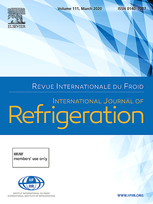
Summary
Owing to the recent uprise in summer temperatures, the use of air conditioners has been increasing accordingly. Air conditioners consume a significant amount of energy, and defects in air conditioners usually could lead to even more consumption of energy. Hence, early detection of defects could not only enhance user satisfaction, but also conserve energy. In the present work, quantitative fault detection models for single- and dual-failure modes have been developed using a support vector machine technique based on refrigeration cycle simulation data including normal and defective conditions. The defect modes investigated in the present work include refrigerant shortage and degraded air flow rates for the evaporator and condenser of an air conditioner. The results indicate that the proposed method can predict the values of more than 95% of the defective parameters within for the single-failure mode, and more than 90% of the data within for the dual-failure mode.
Available documents
Format PDF
Pages: 206-217
Available
Public price
20 €
Member price*
Free
* Best rate depending on membership category (see the detailed benefits of individual and corporate memberships).
Details
- Original title: A study on the quantitative single and dual fault diagnosis of residential split type air conditioners in static operation using support vector machine method.
- Record ID : 30029129
- Languages: English
- Subject: Technology
- Source: International Journal of Refrigeration - Revue Internationale du Froid - vol. 131
- Publication date: 2021/11
- DOI: http://dx.doi.org/10.1016/j.ijrefrig.2021.07.002
- Document available for consultation in the library of the IIR headquarters only.
Links
See other articles in this issue (95)
See the source
Indexing
-
Estimation of Ranque-Hilsch vortex tube perform...
- Author(s) : DOGAN A., KORKMAZ M., KIRMACI V.
- Date : 2023/06
- Languages : English
- Source: International Journal of Refrigeration - Revue Internationale du Froid - vol. 150
- Formats : PDF
View record
-
Computer vision and machine learning methods fo...
- Author(s) : YANG B., ZHU X., WEI B., LIU M., LI Y., LV Z., WANG F.
- Date : 2023/02
- Languages : English
- Source: Energies - vol. 16 - n. 3
- Formats : PDF
View record
-
Research on vibration and noise characteristics...
- Author(s) : SONG Y., MA Q., ZHANG T., LI F., YU Y.
- Date : 2023/10
- Languages : English
- Source: International Journal of Refrigeration - Revue Internationale du Froid - vol. 154
- Formats : PDF
View record
-
Research on fault diagnosis strategy of air-con...
- Author(s) : MA Q., YUE C., YU M., SONG Y., CUI P., YU Y.
- Date : 2024/02
- Languages : English
- Source: International Journal of Refrigeration - Revue Internationale du Froid - vol. 158
- Formats : PDF
View record
-
A comprehensive review: Fault detection, diagno...
- Author(s) : SINGH V., MATHUR J., BHATIA A.
- Date : 2022/12
- Languages : English
- Source: International Journal of Refrigeration - Revue Internationale du Froid - vol. 144
- Formats : PDF
View record
